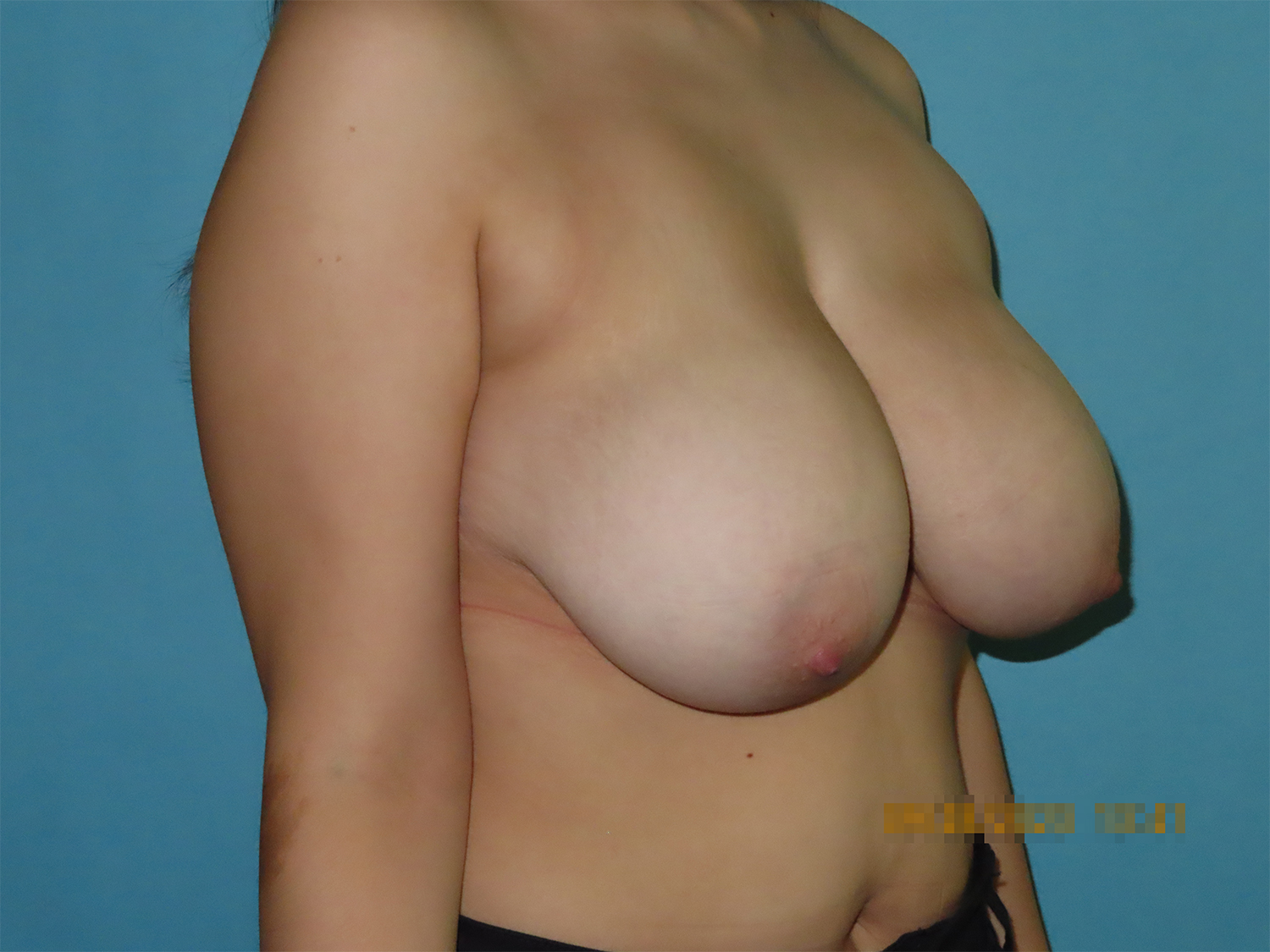Breast reduction is a breast surgery usually performed for physical relief rather than simply cosmetic improvement. Most women who have the surgery are troubled by very large, sagging breasts that restrict their activities and cause them physical discomfort.
In most cases, breast reduction isn’t performed until a woman’s breasts are fully developed; however, it can be done earlier if large breasts are causing serious physical discomfort. The best candidates are those who are mature enough to fully understand the procedure and have realistic expectations about the results. Breast reduction is not recommended for women who intend to breast-feed.
Breast Reduction Risks
Breast reduction is not a simple operation, but it’s normally safe when performed by a qualified plastic surgeon. Nevertheless, as with any surgery, there is always a possibility of complications, including bleeding, infection, or reaction to the anesthesia. Some patients develop small sores around their nipples after surgery; these can be treated with antibiotic creams. You can reduce your risks by closely following your physician’s advice both before and after surgery.
The procedure does leave noticeable, permanent scars, although they’ll be covered by your bra or bathing suit. (Poor healing and wider scars are more common in smokers.) Therefore, Dr. Lille will require a patient to discontinue smoking for 6 weeks before the procedure. The procedure can also leave you with slightly mismatched breasts or unevenly positioned nipples. Future breast-feeding may not be possible, since the surgery removes many of the milk ducts leading to the nipples.
Some patients may experience a permanent loss of feeling in their nipples or breasts. Rarely, the nipple and areola may lose their blood supply and the tissue will die. (The nipple and areola can usually be rebuilt, however, using skin grafts from elsewhere on the body.)
Planning your Breast Reduction Surgery
Dr. Lille will examine and measure your breasts.Dr. Lille will discuss the variables that may affect the procedure-such as your age, the size and shape of your breasts, and the condition of your skin. You should also discuss where the nipple and areola will be positioned; they’ll be moved higher during the procedure, and should be approximately even with the crease beneath your breasts.
Dr. Lille will describe the procedure in detail, explaining its risks and limitations and making sure you understand the scarring that will result.
Preparing for your Breast Reduction Surgery
Dr. Lille may require you to have a mammogram (breast x-ray) before surgery. You’ll also get specific instructions on how to prepare for surgery, including guidelines on eating and drinking, smoking, and taking or avoiding certain vitamins and medications. Some surgeons suggest that their patients diet before the operation.
Breast Reduction Surgery
Breast reduction is generally done in an ambulatory surgical facility, as an outpatient procedure. The surgery itself usually takes three hours, but may take longer in some cases. You can expect to remain in the recovery room for several hours after the surgery. Breast reduction is nearly always performed under general anesthesia. You’ll be asleep through the entire operation.
Techniques for breast reduction vary, but the most common procedure involves an anchor-shaped incision that circles the areola, extends downward, and follows the natural curve of the crease beneath the breast. The surgeon removes excess glandular tissue, fat, and skin, and moves the nipple and areola into their new position. Dr. Lille then brings the skin from both sides of the breast down and around the areola, shaping the new contour of the breast. Liposuction may be used to remove excess fat from the armpit area.
In most cases, the nipples remain attached to their blood vessels and nerves. However, if the breasts are very large or pendulous, the nipples and areolas may have to be completely removed and grafted into a higher position. (This will result in a loss of sensation in the nipple and areolar tissue.)
Under the skin stitches are usually located around the areola, in a vertical line extending downward, and along the lower crease of the breast. In some cases, techniques can be used that eliminate the vertical part of the scar.
Before & After Patient Photos
Breast Reduction Surgery Recovery
After surgery, you’ll be wrapped in an elastic bandage or a surgical bra over gauze dressings. A small tube may be placed in each breast to drain off blood and fluids for the first day or two.
You may feel some pain for the first couple of days — especially when you move around or cough — and some discomfort for a week or more. Dr. Lille will prescribe medication to lessen the pain.
The bandages will be removed a day or two after surgery, though you’ll continue wearing the surgical bra around the clock for several weeks, until the swelling and bruising subside. If your breast skin is very dry following surgery, you can apply a moisturizer several times a day, but be sure to keep the suture area dry.
You may also experience random, shooting pains for a few months. You can expect some loss of feeling in your nipples and breast skin, caused by the swelling after surgery. This usually fades over the next six weeks or so. In some patients, however, it may last a year or more, and occasionally it may be permanent.
Breast Reduction Surgery Aftercare
Although you may be up and about in a day or two, your breasts may still ache occasionally for a couple of weeks. You should avoid lifting or pushing anything heavy for three or four weeks.
Your surgeon will give you detailed instructions for resuming your normal activities. Most women can return to work (if it’s not too strenuous) and social activities in about two weeks. But you’ll have much less stamina for several weeks, and should limit your exercises to stretching, bending, and swimming until your energy level returns. You’ll also need a good athletic bra for support.
You may be instructed to avoid sex for a week or more, since sexual arousal can cause your incisions to swell, and to avoid anything but gentle contact with your breasts for about six weeks.
A small amount of fluid draining from your surgical wound, or some crusting, is normal. If you have any unusual symptoms, such as bleeding or severe pain, don’t hesitate to call your doctor.
Breast Reduction Surgery Results
Although much of the swelling and bruising will disappear in the first few weeks, it may be six months to a year before your breasts settle into their new shape. Even then, their shape may fluctuate in response to your hormonal shifts, weight changes, and pregnancy.
Dr. Lille will make every effort to make your scars as inconspicuous as possible. Still, it’s important to remember that breast reduction scars are extensive and permanent. They often remain lumpy and red for months, then gradually become less obvious, sometimes eventually fading to thin white lines. Fortunately, the scars can usually be placed so that you can wear even low-cut tops.
Of all plastic surgery procedures, breast reduction results in the quickest body-image changes. You’ll be rid of the physical discomfort of large breasts, your body will look better proportioned, and clothes will fit you better. However, it is important to know that the final look of a breast reduction will eventually result in a bottom out look where only a small saline implant will create the fullness in the upper pole of the breast.
Breast Reduction Questions and Answers
What is a breast reduction?
Breast Reduction is removing excess breast tissue along with extra skin, reducing the areola diameter and raising the nipple areola complex.
How much breast tissue can be removed?
A significant amount of breast tissue can be removed. It largely depends upon how much the patient wants removed. There is a limitation however, since enough tissue must remain in order to preserve the blood supply to the nipple areola complex.
Are there scars with breast reduction?
Yes, the scar pattern is around the areola, vertically from the areola down to the breast fold and horizontally along the breast fold. Drawn on paper is in the shape of an anchor. Scars take approximately one year to mature and turn light. In some cases, it may be as long as two years.
Are any drains required for breast reduction?
Yes, drains are required to remove the excess fluid that occurs with immediately following surgery. Drains are usually removed within a week after surgery.
How long is the recovery for breast reduction surgery?
Breast reduction surgery is a relatively painless surgery since no muscles or bones are involved. Returning to a desk job following breast reduction surgery can occur between 8-14 days depending on how the individual patient is progressing following surgery. Physical activity is usually resumed at three weeks, although running and swimming should not be resumed for six to eight weeks following surgery. It takes approximately 3-4 months for 70% of the swelling to resolve and an additional 9 months for all of the swelling to be gone.
How do the breast reduction results appear after all the swelling goes down?
The skin and breast tissue from breast reduction is weak by nature with the suspensory ligaments of the breast significantly lax. As a result, over time, the breast tissue may once again fall to the bottom of the breast although the nipple areola complex will remain above the breast fold and usually always maintain its position. When that happens, an implant can be placed below the breast tissue to restore upper breast fullness, significantly reducing the “bottomed out” look. Implants cannot be placed at the same time as a breast reduction since the vascular supply to the nipple complex is in the way of where an implant is placed. Implants are usually placed anywhere from six months to a year after breast reduction surgery if so desired.
Can I breast feed after breast reduction?
There is a potential risk that a patient may not be able to breast feed following breast reduction surgery. Significant breast tissue is removed and the ducks that are responsible for carrying the milk to the nipple are irreversibly interrupted. Therefore breast feeding may be inhibited. For those women who wish to breast feed should seriously consider delaying breast reduction surgery until after child bearing is done.
Does insurance cover breast reduction surgery?
Insurances can be very complex regarding coverage and can vary drastically from one insurance company to another. There are cases where breast reduction surgery may be covered. This requires extensive documentation of symptoms and treatments usually to include six months of chiropractic or physical therapy, documentation of neck, back, shoulder pain, significant shoulder grooves from bra straps, chronic rashes underneath the breast as well as being on chronic therapy for neck and back pain including the chronic use of non- steroidals and other medications. Multiple physician referrals may also be required. Although Dr. Lille does not accept insurance plans, our staff will be happy to provide you with the codes to give to your insurance.




